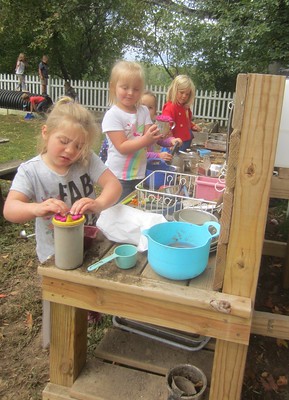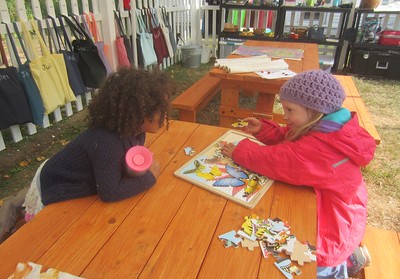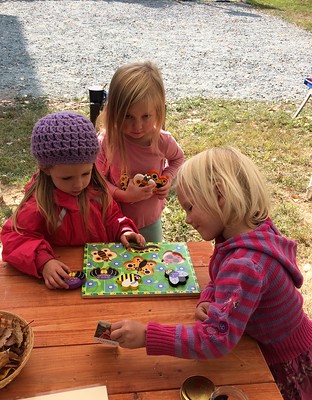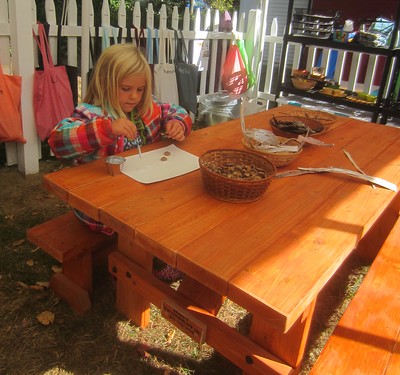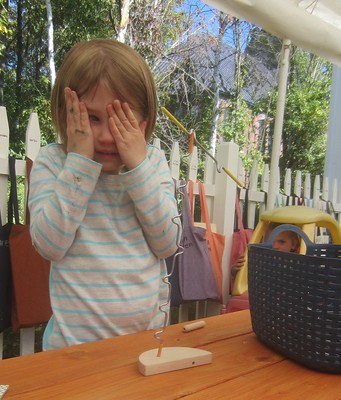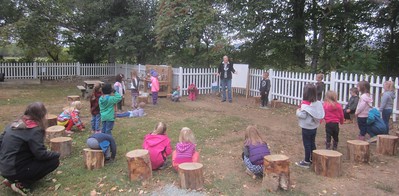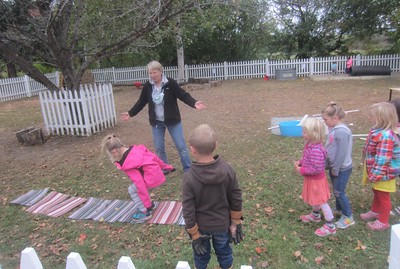The children were super excited to use the new sandbox! They did lots of climbing, jumping, digging, pouring, and hauling. Thank you Ian Schulte!
Monday students listened to the story To Be An Artist by Maya Ajmera and saw that an artist is someone who expresses themselves through drawing, painting, dancing, performing, playing instruments, sculpting, creating, etc. The Sunnybrook artists were then introduced to color mixing. They used the three primary colors, red, yellow, and blue, to create new colors. They used Q-tips to combine red and yellow into shades of orange, yellow and blue into shades of green, and red and blue into purple. When they mixed all the colors together they made shades of brown. We read White Rabbits Color Book by Alan Baker and Mouse Paint by Ellen Stoll Walsh.
We continued to discuss school strategies and expectations. We demonstrated how to get a teacher’s attention by placing a hand on her shoulder, hand, or a pocket. We also demonstrated how to ask for help and offer help. We practiced asking a friend or teacher for help by saying, “Will you please help me with _________” rather than saying, “I can’t do this” or making noises of frustration. We discussed how we can offer help as well and how we can respond when help is offered. Sometimes people really appreciate help, and sometimes they prefer to try themselves. We can ask, “Would you like help?” then listen for a “yes, please” or “no, thank you” before assisting, or respectfully saying “Okay” and walking away.
The children shared all the rules they could think of that we should follow to be safe, respectful, and kind, our three overarching expectations, and why we have these rules – what could happen if we don’t follow them. They had a lot of great suggestions to make our school a safe, respectful, and enjoyable learning environment. Some of their rules were, No hitting, kicking, or punching, walk inside but you can run outside, stay off the fence, don’t be mean, don’t climb on the mud kitchen, don’t smoosh Daddy long legs, don’t run on the stumps, don’t pour sand on people, don’t disrupt or destroy people’s work, etc.
We began to introduce exploring our natural environment around us, and documenting what we observe and wonder. We began to learn about trees by reading a bit about the three main parts of a tree – the crown, trunk, and roots, and how we need trees to live, specifically the exchange of oxygen and carbon dioxide between trees and humans and other animals. We breathed deeply in, pulling in oxygen from the plants and trees, and deeply out, expelling carbon dioxide for the plants and trees to breath in. Susan taught us two great songs by Billy B. about trees that we acted out; “Yippee Hooray I am a sprout” about an acorn growing up into a sprout and “This Bark on Me,” about how bark protects a tree from insects, elements, and disease.
Kindergarten students, and any others who chose to participate, have really enjoyed documenting our days at school and finding patterns in the number line they are creating on the fence. They have been using the patterns to skip count and have been jumping between stumps, mats, etc. while counting by 2’s and 3’s. They created Bb’s out of birch bark strips and colored an equal number of dots on each side of some ladybugs.
Friday science students named some fruits and vegetables that grow on trees and plants. We discussed how some vegetables are the fruit part of the plant, such as squash and tomatoes. We cut open and talked about the part of the fruit. We examined an apple, pear, banana, zucchini, and tomato. The children wondered if all of the fruits had seeds, and some hypothesized that the banana and zucchini do not, but the apple, pear, and tomato do. After cutting them open, the children examined them to look for seeds, and discovered that they all had seeds, though some were quite small. Finally, they observed that they each had a skin on the outside, some flesh under the skin, seeds in the middle, a stem where it attached to the plant, and spot at the bottom where the flower was. (Sorry, I forgot to take photos)!






















